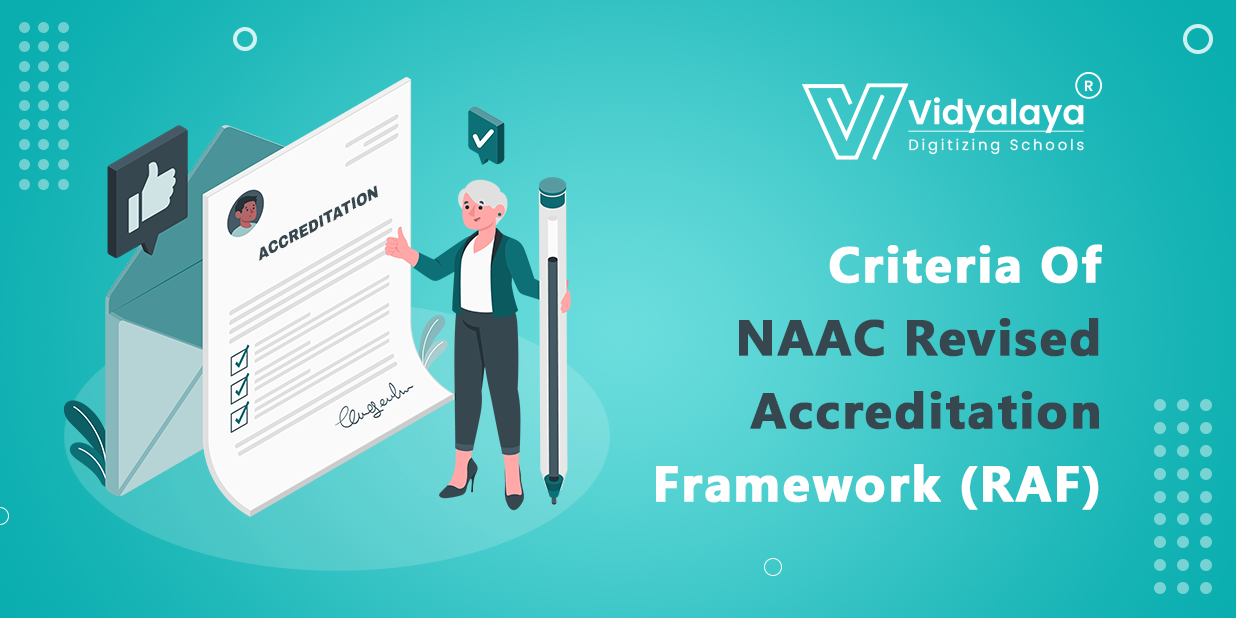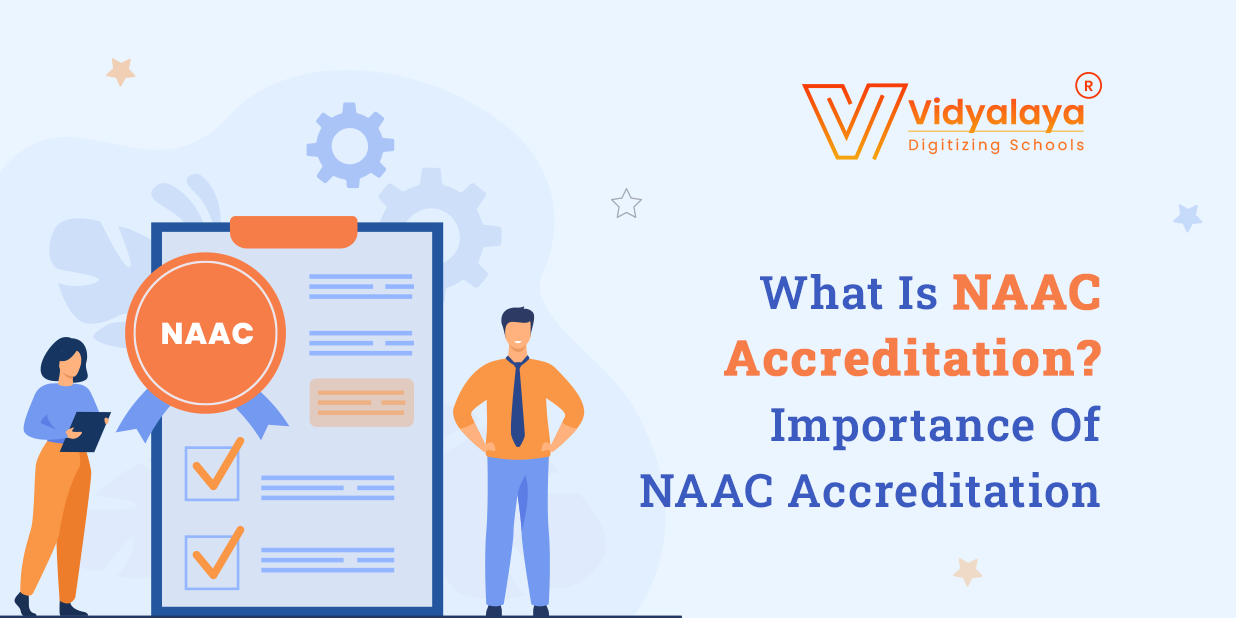After the pandemic, the new education policy has regained its form and the Indian education system is matching the steps of a global educational platform. Not to be surprised, the NAAC revised accreditation framework is the key to this. Educational institutes can achieve better transparency, scalability, and robustness with the transformation. The committee guidelines aim on the improve enrolment and better quality of education.
We all know that the NAAC Accreditation process is three-tired. The entire process concentrates on student satisfaction surveys and data verification and validation. The phases are:
- Institutional Information for Quality Assessment and Self-Study Report- It represents the intent of higher education institutes to apply for the NAAC assessment and accreditation process.
- Data validation & verification and Pre-qualifier score- The submitted application is verified and evaluated for online assessment. Institutes with less than 30% score on quantitative metrics are eligible for onsite peer review.
- Preparation for Student Satisfaction Survey- Prepare this student satisfaction survey report and collect feedback from at least 10% of total enrolled students.
- Onsite assessment or peer review by the team- The peer review focuses on the student satisfaction aspect. An institute needs to score at least 30% for the NAAC accreditation process. A team from NAAC inspects the institute and prepares review reports.
What are the changes in NAAC Revised Accreditation Framework?
NAAC Revised Accreditation Framework (RAF) has undergone some changes and these are:
- Focusing on Quantitative evaluation rather than qualitative peer judgment dependency based on fact data. This move aims at objectivity improvement and transparency in the NAAC Accreditation process.
- Setting up benchmarks in the NAAC indicators to improve the quality of education.
- Encouraging the increasing use of information and communication technology in learning and improving its scalability and robustness.
- Improving the NAAC Accreditation process by working on factors like the number of questions, size of reports, visiting days, etc.
- Encourage student and alumni participation to improve the assessment process.
- Modifying the process by introducing system-generated scores in combination with online evaluation (70%) and peer judgment (30%).
What are the criteria for the NAAC Revised Accreditation Framework?
According to guidelines issued in NAAC 2020, there are certain criteria for NAAC RAF and they are:
1. Modifying the Curriculum, Pedagogy, Assessment, and Student Report:
The learning process is for livelihood and knowledge. Curriculum plays a guidance role in the entire academic process, so if educational institutes need to reform it. This will give value-based education and an enriched learning experience. But at the same time, educational institutes need to pay attention towards developing assessment strategies for measuring learning outcomes. All this is done to make the students independent learners and enable them in the decision-making process so that they don’t rely on other’s opinions blindly. Students can communicate well, maintain good relationships, and become well-rounded individuals when the curriculum is modified according to today’s requirements.
2. Learning, Teaching, and Assessment:
The grasping capacity of all students is not equal, so teaching a lesson may yield unequal outcomes for all. As the success of learning is directly proportional to the success of teaching, teaching styles must be apt for changed learning styles. Teachers can make weekly or monthly assessments to track their progress. This will also help to identify the learning gaps and make necessary modifications in the teaching process.
3. Research and Innovation:
NAAC accreditation is all set to improve higher education and institutes need to establish start-up incubation centres and technology development centres. These advanced amenities will help students to focus on research and innovation. The aim behind this is to address various research criteria and also contribute to society’s development. NAAC accreditation illustrates the collaboration ways with research bodies and offers help in research that are society-development-centred.
4. Infrastructure and Learning Resources:
Investment in infrastructure development and maintaining learning resources is inevitable for educational institutes. Educational institutes must have some budgetary provisions for libraries or e-library development as needs of the hour. While paying for these reasons, procurement and its usage should be considered well, and accordingly, necessary budget requirements should be arranged.
5. Governance Leadership & Management:
Educational administration and leadership should be strong enough to identify and sustain in the throat-cutting competition. This leadership must be polished by educational values and visions. It also matters how leadership can come up with strategies for development, proper resource allocation and usage, and the entire decision-making process. NAAC 2020 supports strong and efficient governance leadership and management to keep the entire learning process on the right path.
6. Institutional Values & Best Practices:
Education is beyond academics and is sustainable for livelihood and society development. Students of higher education institutes should emerge as socially conscious individuals considering liberty, justice, equality, and other social skills. All these are dripped down by the students when institutional values are highly carved. Educational institutes play a significant role in carving students into sensitized citizens with self-awareness and organizational capacities.
7. Student Support & Progression:
Student lifecycle commences when he/she registers for the enrolment and ends up becoming an alumnus of the institute. Even after finishing the course, alumni students are important to institutes as they are the brand ambassadors of the institute. NAAC revised accreditation framework recognizes this importance and enables institutes to develop and sustain a reliable network with their ex-students. A strong alumni network can help in various aspects like:
- Become a mentor for students and provide the necessary guidance
- Academic support for the students who are failing to match the pace or facing difficulty
- Exploring career opportunities and guiding the same.
- Mentoring students about the latest trends, and maintaining mental and physical health.
NAAC accreditation is an important move, especially in higher education. They need to acquire all necessary documentation and preparation adhering to accreditation process guidelines. To survive through this tedious process, EdTech software organizations like Vidyalaya can help you. We can provide all types of guidance and help through our top-notch products to get NAAC accreditation with a good score. Lay a robust foundation with the NAAC Revised Accreditation Framework by partnering with us in this challenging journey. Gear up for more significant changes in the National Educational Policy 2020 and let your educational brand shine like never before with Vidyalaya.





















